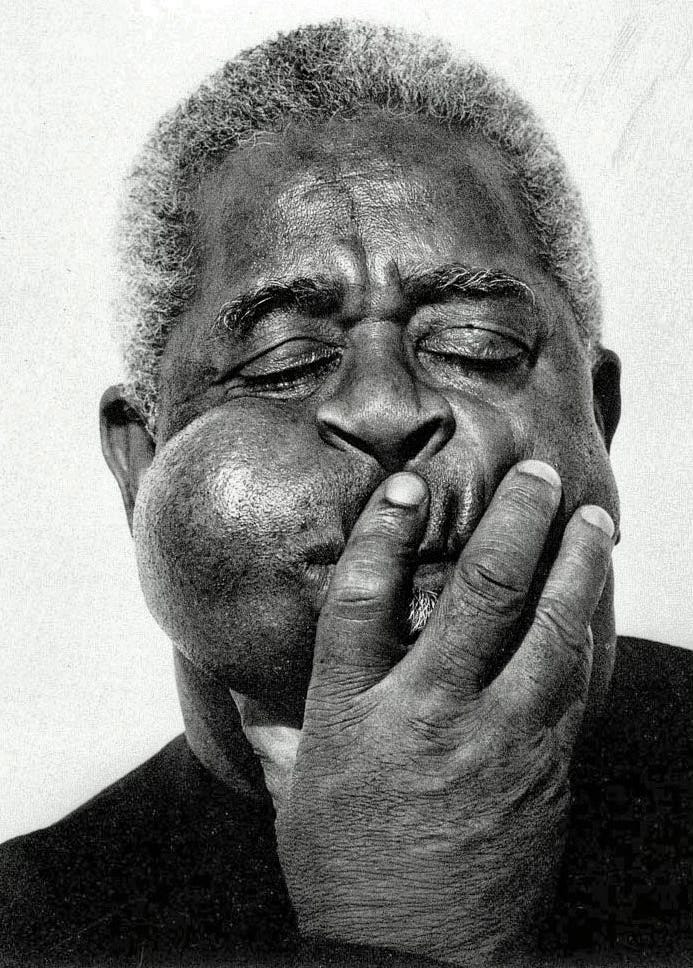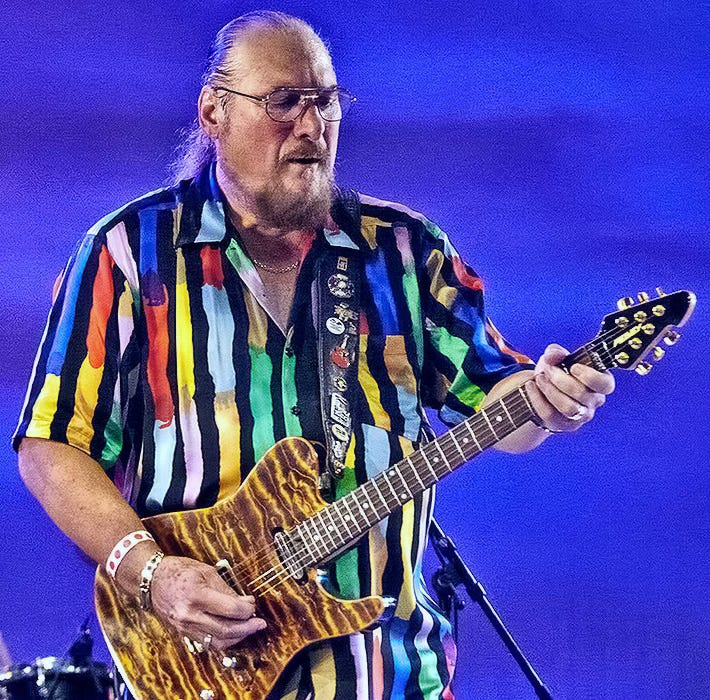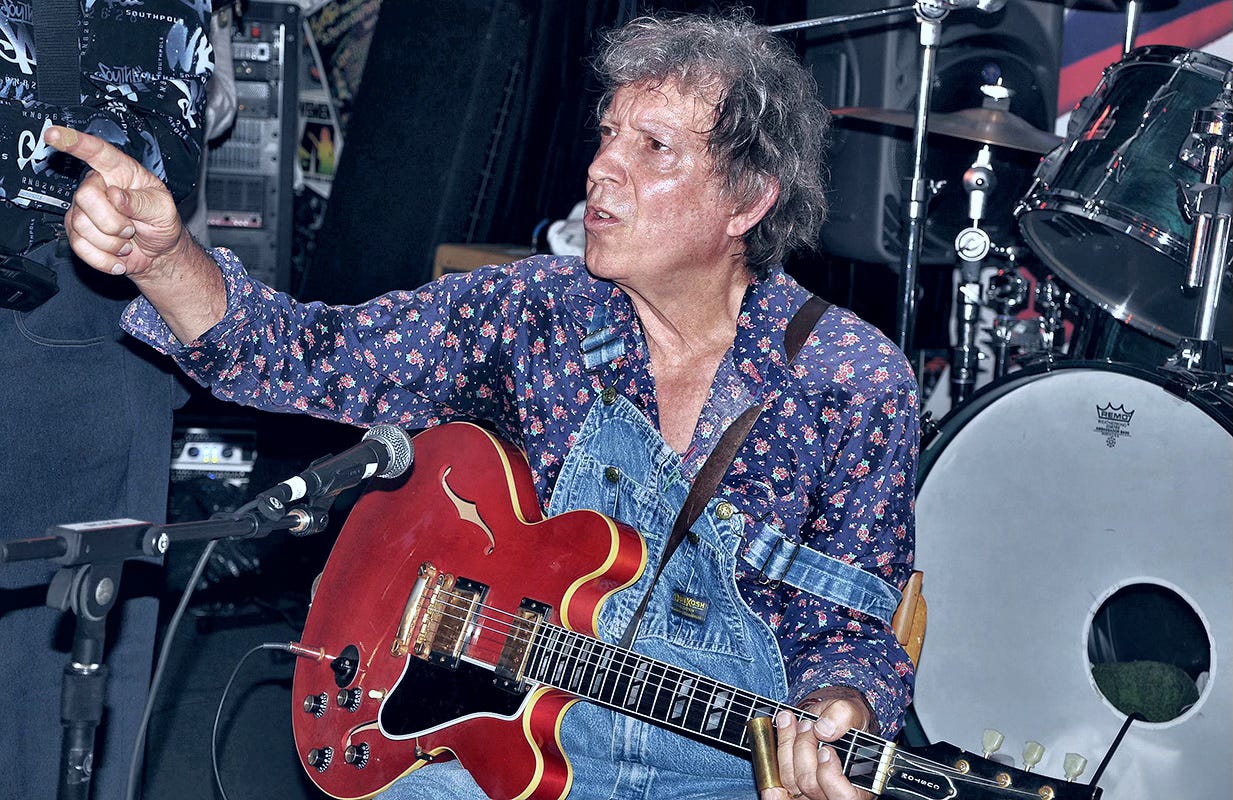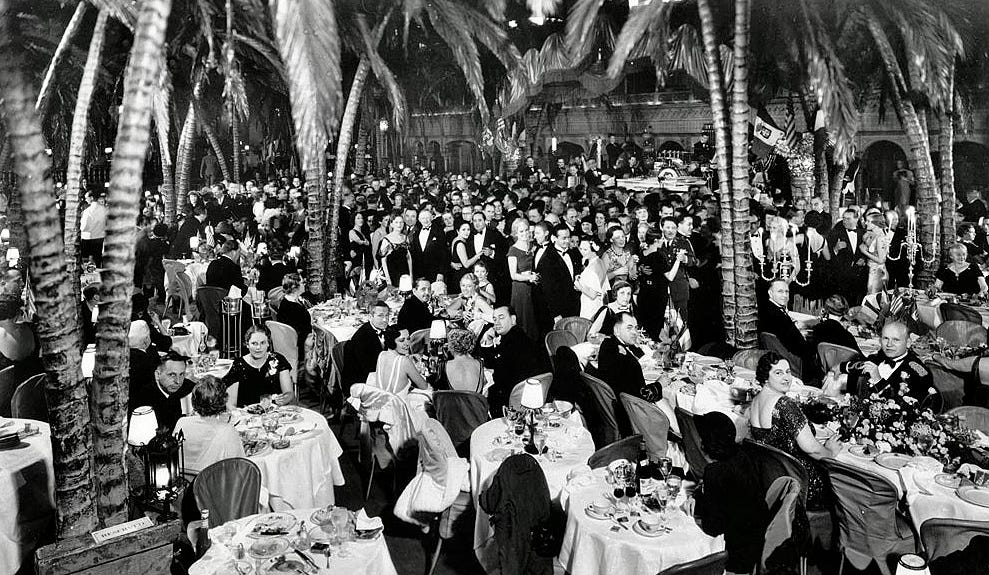Dizzy Gillespie, one of the great trumpeters in jazz history, was born 105 years ago today
Dizzy Gillespie, 1978
Photo by Herb Ritts
Dizzy Gillespie, one of the great trumpeters in jazz history, was born 105 years ago today.
An iconic figure in the history of jazz music who was instantly recognizable even to millions of non-jazz fans by his puffed-out cheeks and his trademark trumpet, with its horn bent upwards at a 45-degree angle, John Birks Gillespie — better known as "Dizzy" — was born on this day in 1917 in Cheraw, South Carolina.
The youngest of nine children in a musical family, Gillespie began playing piano at the age of four and took up the trombone and trumpet at the age of 12.
He showed enough talent on the latter instrument to earn a music scholarship to North Carolina's Laurinburg Institute at the age of 15, but even through his high school years, Gillespie was essentially self-taught.
In the late 1930s, at the height of the Swing era, Gillespie worked his way through a succession of increasingly prestigious big bands, earning a reputation as a talented performer and as a free spirit worthy of the nickname, "Dizzy."
By 1939, at the age of 22, he was playing for Cab Calloway, one of the most successful bandleaders of the time.
Dizzy would stay with Calloway's band through 1941, but more important than the recordings on which he appeared during this period were the connections he made with fellow musicians who would greatly influence the next phase of his career — musicians that included the great saxophonist, Charlie "Bird" Parker and the pianist, Thelonious Monk.
During their late-night jam sessions in the early 1940s at New York clubs like Minton's Playhouse in Harlem, Gillespie, Parker and Monk, among several others, established an entirely new sound in jazz: bebop.
Because of a recording ban instigated by union musicians during the bulk of World War II, the evolution of bebop was not documented in commercial recordings. In the postwar era, however, the revolutionary new style took the jazz world by storm and established Gillespie's international reputation.
In addition to acting as one of bebop's founding fathers, Dizzy Gillespie also pioneered the fusion of Afro-Cuban rhythms with jazz music in the 1940s, helping to create another jazz genre of enormous popularity and importance.
Gillespie died of pancreatic cancer on January 6, 1993 at the age of 75.
He taught and influenced many other musicians, including trumpeters Miles Davis, Fats Navarro, Clifford Brown, Arturo Sandoval, Lee Morgan, Jon Faddis and Chuck Mangione.
Thanks History.com
Here, Gillespie performs “A Night In Tunisia” in 1981.
Steve Cropper plays at the Stax Records tribute at Lincoln Center in New York City, August 14, 2011
Photo by Frank Beacham
Steve Cropper is 82 years old today.
Steve "The Colonel" Cropper is a guitarist, songwriter and record producer and best known as the guitarist of the Stax Records house band, Booker T. & the M.G.’s.
He has backed artists such as Otis Redding, Sam & Dave, Carla Thomas, Rufus Thomas and Johnnie Taylor, also acting as producer on many of their records. Cropper later gained fame as a member of the Blues Brothers band.
When he was nine years old, Cropper moved with his family to Memphis. At the age of ten, he strummed his brother-in-law's Gibson guitar for the first time. Cropper received his first guitar by mail order at 14 and started playing with local musicians.
His guitar heroes at the time included Lowman Pauling of the "5" Royales, as well as Chet Atkins, Chuck Berry, Tal Farlow, Jimmy Reed and the guitarist of the Bill Doggett band, Billy Butler.
Cropper and guitarist, Charlie Freeman, formed the Royal Spades, who eventually became the Mar-Keys. The name referred to the marquee outside Stax studios, known as Satellite Records at the time. Eventually the Mar-Keys began playing on sessions and had a hit single of their own with "Last Night" in 1961.
When American Records founder Chips Moman left Stax, Cropper was promoted to the company's A&R man. He became a founding member of the Stax house band, Booker T. & the M.G.'s, along with Hammond organ player Booker T. Jones, bassist Donald "Duck" Dunn and drummer Al Jackson Jr.
As a house guitarist, he played on many recordings such as "(Sittin' on) the Dock of the Bay," co-written with and performed by Otis Redding, and Sam & Dave's "Soul Man," on which he was mentioned by name.
When Cropper played on the song's remake by the Blues Brothers, lead singer John Belushi again mentioned Cropper. At this time Cropper's fame was not limited to the United States. The Beatles favored Cropper's playing and his production on Otis Redding records.
John Lennon and Paul McCartney made tentative plans to record in Memphis, and to work with the guitarist. However Brian Epstein cancelled the sessions, citing security problems.
Regarding this period, Rob Bowman, in his book, Soulsville U.S.A.: The Story Of Stax Records, quoted Booker T. Jones as saying: “We were writing sounds too, especially Steve. He's very sound-conscious, and he gets a lot of sounds out of a Telecaster without changing any settings — just by using his fingers, his picks and his amps”
Along with influential work with Booker T & The MG's, Cropper co-wrote "Knock On Wood" with Eddie Floyd, "In the Midnight Hour" with Wilson Pickett and "(Sittin' On) The Dock of the Bay" with Otis Redding. In 1969, Cropper released his first solo album, With a Little Help From My Friends.
In 1978, Cropper and Dunn became members of Levon Helm's RCO All-Stars, and then went on to figure prominently in the Blues Brothers Band with the drummer Willie Hall. This led to two albums and two movie soundtracks.
Cropper also re-recorded "(Sittin' On) The Dock of the Bay" (1979) for Sammy Hagar. Cropper lived in Los Angeles for the next thirteen years before moving to Nashville and reuniting with the Blues Brothers Band in 1988.
In 1992, Booker T. & the M.G.'s were inducted into the Rock and Roll Hall of Fame, and Cropper appeared with a new line-up of the group for the Bob Dylan 30th Anniversary concert, on October 1992 at Madison Square Garden, performing songs by and backing Dylan, Eric Clapton, George Harrison, Tom Petty, Johnny Cash, Chrissie Hynde, Sinéad O'Connor, Stevie Wonder and Neil Young.
The concert was recorded and later released as The 30th Anniversary Concert Celebration (1993).
Neil Young later recruited this line up of Booker T. and the M.G's, to tour with him and record as his studio band.
In 1996, Cropper was named "the greatest living guitar player" by Britain's Mojo magazine. When asked what he thought of Cropper, the guitarist Keith Richards said, "Perfect, man."
In February, 1998, Cropper released Play It, Steve! which included some of soul music's most enduring songs. The album title came from the "shout" of the title phrase by Moore on Sam & Dave's "Soul Man," and later by John Belushi (with the Blues Brothers).
Here’s Cropper on how Booker T. and the MGs did “Green Onions.”
New Morning, Bob Dylan’s 11th studio album, was released on this day in 1970 — 52 years ago today.
Coming only four months after the controversial Self Portrait, New Morning won a much warmer reception from fans and critics. It reached #7 in the U.S., quickly going gold.
Harvey Brooks played bass during the final sessions for New Morning, after having performed on Dylan’s Highway 61 album a few years earlier.
Here is Harvey’s account of how he became involved on the session.
----
On the recording of Bob Dylan’s New Morning
By Harvey Brooks
One sunny afternoon in the Fall of 1970, I was upstairs working in my Woodstock house on a painting. It was inspired by some dying flies falling off the large picture window directly in front of me onto my already abstract canvas.
The phone rang. It was Levon Helm calling to tell me he had given Bob (Dylan) my new phone number. Was it all right? About an hour later, Dylan called. He said if I wasn’t doing anything he would stop by — if I was alone. I was and he did.
We sat in my living room and started talking about what was going on in Woodstock. I made some coffee and as we talked, Dylan’s eyes seemed to be capturing a picture of the room that stopped at the chessboard. I asked, do you play? His answer came in his move to the table where my chessboard sat.
I’ll give you Queen odds in the first game, he said. If you win, we’ll make it rook odds. We both laughed, lit up a joint and Bob made the first move across the board, with our back and forth repartee about our former manager, Albert Grossman.
Bob’s stories about Albert and their falling out centered on management fees and publishing. I left working for Albert because we did not have a signed contract and he never wanted to pay me what I thought I was worth. Albert was an arrogant and assertive guy. He, as I have written earlier in the book, managed Peter, Paul and Mary, Janis Joplin, Richie Havens and Todd Rundgren. Most of his relationships ended bitterly.
Oddly, Albert is still a good part of what Woodstock is today. He created the artist colony that is still a haven to many musicians and his Bearsville Theater complex continues to prosper.
As we continued across the chess board, Bob suggested that I read the book, The Death Ship. It is a novel by the pseudomonas author known as B. Traven. The setting, as Bob shared it, was the predicament of a merchant seaman who had lost his passport/citizenship papers and cannot find any legal residence or employment in any nation.
The character in the book is repeatedly arrested and deported from one country to the next by government officials who do not want to be bothered with helping or jailing him. Bob embellished the story of the ship by saying that the workers from around the world were treated as expendable slaves. B. Traven also wrote The Treasure of The Sierra Madre. I do not remember if Bob or I took the game!
A few weeks later, I got a call from Al Kooper booking me on a series of sessions for Bob’s New Morning album, being recorded at Columbia Studio E. Prior to my being called for the session, Bob had gone through many players. They’d done a lot of recording in Nashville and New York, but still hadn’t gotten the tunes the way Bob wanted them.
Al knew that we were all comfortable together, and hoped that the sessions would go smoothly. There was a lot of burnt out emotion in the studio when I got there, and I couldn’t miss the frustration that Bob and Al were going through. The room was like sitting in a pressure cooker that was ready to blow! It took awhile for everyone to settle into a groove.
I played on If Not for You, Day of the Locusts, One More Weekend, Father of Night and The Man In Me. My performance is pretty much about the feel of the song.
What I do is listen to a combination of the rhythm and chords and find a basic part that fits. Then I evolve the part as the song comes together. It’s just moving and bridging sections so that the tunes becomes comfortable.
That’s what I did on New Morning and it worked.
From Harvey Brook’s book, “View from the Bottom.”
Elvin Bishop is 81 years old today.
A blues and rock and roll musician and guitarist, Bishop was born in Glendale, California, and grew up on a farm near Elliott, Iowa.
His family moved to Tulsa, Oklahoma, when he was ten years old. There he attended Will Rogers High School, winning a full scholarship to the University of Chicago as a National Merit Scholar finalist. Upon graduation, he moved to Chicago in 1960 to attend school, where he majored in physics.
In 1963, he met harmonica player, Paul Butterfield, in the neighborhood of Hyde Park and joined Butterfield's blues band, with whom he remained for five years. Their third album, The Resurrection of Pigboy Crabshaw, takes its name from Bishop's nickname.
In 1968, he went solo and formed the Elvin Bishop Group. He also performed on the album, The Live Adventures of Mike Bloomfield and Al Kooper. The group signed with Fillmore Records, which was owned by Bill Graham, who also owned the music venues of the same name.
In March, 1971, The Elvin Bishop Group and The Allman Brothers Band co-billed a series of concerts at the Fillmore East. Bishop joined The Allman Brothers Band onstage for a rendition of his own song, "Drunken Hearted Boy.”
Over the years, Bishop has recorded with many other blues artists including Clifton Chenier and John Lee Hooker. In late 1975, he played guitar for a couple of tracks on Bo Diddley's The 20th Anniversary of Rock 'n' Roll album, and in 1995, he toured with B.B. King.
Here, the Elvin Bishop Band performs “Rock My Soul” in 1981.
Owen Bradley is shown in his studio in the early 1970s with Loretta Lynn
Owen Bradley, Nashville record producer, was born 107 years ago today.
Along with Chet Atkins and Bob Ferguson, Bradley was one of the chief architects of the 1950s and 1960s Nashville sound in country music and rockabilly.
A native of Westmoreland, Tennessee, Bradley learned piano at an early age, and began playing in local nightclubs and roadhouses when he was a teenager. At 20, he got a job at WSM-AM radio, where he worked as an arranger and musician.
In 1942, he became the station's musical director, and was also the leader of a sought-after dance band, joined later by vocalists, Bob Johnstone and Dottie Dillard, that played at well-heeled society parties all over the city.
That same year, Bradley co-wrote Roy Acuff’s hit, “Night Train to Memphis." He kept the band up until 1964, although in the intervening decades, his work as a producer would far overshadow his own performing career.
In 1947, Bradley took a position as a music arranger and songwriter at Decca Records. He worked for Paul Cohen on recordings by some of the biggest talents of the day, including Ernest Tubb, Burl Ives, Red Foley and Kitty Wells. Learning from Cohen, he eventually began to produce records on his own.
When his mentor left the label in 1958, Bradley became vice president of Decca's Nashville division, and began pioneering what would become the "Nashville sound." Country music had long been looked on as unsophisticated and folksy, and was largely confined to listeners in the less affluent small towns of the American South and Appalachia.
In the late 1950s, Bradley's home base of Nashville was positioning itself to be a center of the recording industry, and not just the traditional home of the Grand Ole Opry.
In fact, the Nashville sound began in a Quonset hut attached to a house Bradley owned with his brother, Harold, at 804 16th Avenue South in Nashville. The Quonset Hut is commonly recognized as the birthplace of a more commercial country music that often crossed over into pop.
This distinct genre of American music was developed primarily by Owen Bradley's crew of hand picked musicians, Grady Martin, Bob Moore, Hank Garland and Buddy Harman — Nashville's "A-Team."
The success of Bradley's Quonset Hut studio spurred RCA Victor to build its famous RCA Studio B. A handful of other labels soon followed setting up shop on what would eventually become known as Music Row.
Bradley and his contemporaries infused hokey melodies with more refined lyrics and blended them with a refined pop music sensibility to create the Nashville sound, known later as Countrypolitan. Light, easy listening piano (as popularized by Floyd Cramer) replaced the clinky honky-tonk piano.
Manfred Mann is 83 years old today.
Born Manfred Sepse Lubowitz in Johannesburg, South Africa, Mann is a keyboard player best known as a founding member and namesake of Manfred Mann and Manfred Mann's Earth Band.
Lubowitz studied music at the University of the Witwatersrand, and worked as a jazz pianist at a number of clubs in Johannesburg. Between 1959 and 1961 he and his childhood friend, Saul Ozynski, recorded two albums as the Vikings – South Africa's first rock and roll band.
Strongly opposed to the apartheid system in his native South Africa, Lubowitz moved to the United Kingdom in 1961 and began to write for "Jazz News" under the pseudonym, Manfred Manne, after jazz drummer, Shelly Manne. Soon, he dropped the final “e,” making the name, Manfred Mann.
The next year he met drummer and keyboard player, Mike Hugg, at Clacton Butlins Holiday Camp and together they formed a large blues-jazz band, the Mann-Hugg Blues Brothers. This eventually evolved into a five-piece group and they signed a record deal with EMI in 1963, under the HMV label.
Their name was changed to Manfred Mann at the suggestion of the label's record producer. From 1964 to 1969, they had a succession of hit records, including "Do Wah Diddy Diddy," "Sha La La," "Pretty Flamingo" and "Mighty Quinn."
The Cocoanut Grove nightclub was located in the Ambassador Hotel in Los Angeles until it was demolished in 2005.
The hotel was the site of six Academy Awards ceremonies between 1930 and 1943, and the June, 1968 assassination of Robert F. Kennedy.
The Ambassador Hotel began operation formally on January 1, 1921, and was located at 3400 Wilshire Boulevard, between Catalina Street and Mariposa Avenue, in the center of the Los Angeles Mid-Wilshire district.
Seven U.S. Presidents stayed at The Ambassador Hotel, from Hoover to Nixon, along with chiefs of state from around the world.
For decades, the hotel's famed Cocoanut Grove nightclub hosted well-known entertainers, such as Frank Sinatra, Barbra Streisand, Judy Garland, Lena Horne, Bing Crosby, Nat King Cole, Liza Minnelli, Martin and Lewis, The Supremes, Merv Griffin, Dorothy Dandridge, Vikki Carr, Evelyn Knight, Vivian Vance, Dick Haymes, Sergio Franchi, Perry Como, Dizzy Gillespie, Benny Goodman, Sammy Davis Jr., Little Richard, Liberace, Natalie Cole and Richard Pryor.
During the 1920s, the Cocoanut Grove was frequented Louis B. Mayer, Charlie Chaplin, Douglas Fairbanks and Mary Pickford, Howard Hughes, Clara Bow, Rudolph Valentino, Gloria Swanson, Anna May Wong and Norma Talmadge.
Joan Crawford went go there once a week to dance the Charleston, where she won more than 100 dance contests.
During the 1930s, the club was frequented by celebrities of cinema such as Norma Shearer and Irving Thalberg, Errol Flynn, Jean Harlow, Clark Gable and Carole Lombard, Katharine Hepburn, Spencer Tracy, Cary Grant, Jimmy Stewart, Marlene Dietrich, Lana Turner, John Wayne, Henry Fonda, Lucille Ball, Ginger Rogers, Gary Cooper and Loretta Young.
In the pantry area of the hotel's main kitchen, soon after midnight on June 5, 1968, and after a brief victory speech in the Embassy Room ballroom of the Ambassador Hotel, the winner of the California Democratic presidential primary election, Senator Robert F. Kennedy (RFK), was shot along with five other people.
Palestinian immigrant, Sirhan Sirhan, was arrested at the scene and later convicted of the murder. Kennedy died one day later from his injuries, while the other victims survived their wounds. The death of Robert F. Kennedy coincided with the beginning of the hotel's demise, hastened by the decline of the surrounding neighborhood.
Despite a renovation of the Cocoanut Grove in the mid-1970s, with the creative control of Sammy Davis, Jr., the hotel was closed in 1989 to guests, but remained open for filming and private events. A liquidation sale of the hotel's contents was conducted in 1991 by National Content Liquidators Inc. based in Ohio.
Emilio Estevez's movie, Bobby, was filmed there during late 2005, even as the adjoining wing was being demolished.
On this day in 1959 — 64 years ago today — on New York City's Fifth Avenue, thousands of people lined up outside a bizarrely shaped white concrete building that resembled a giant upside-down cupcake.
It was opening day at the new Guggenheim Museum, home to one of the world's top collections of contemporary art.
Mining tycoon Solomon R. Guggenheim began collecting art seriously when he retired in the 1930s. With the help of Hilla Rebay, a German baroness and artist, Guggenheim displayed his purchases for the first time in 1939 in a former car showroom in New York.










